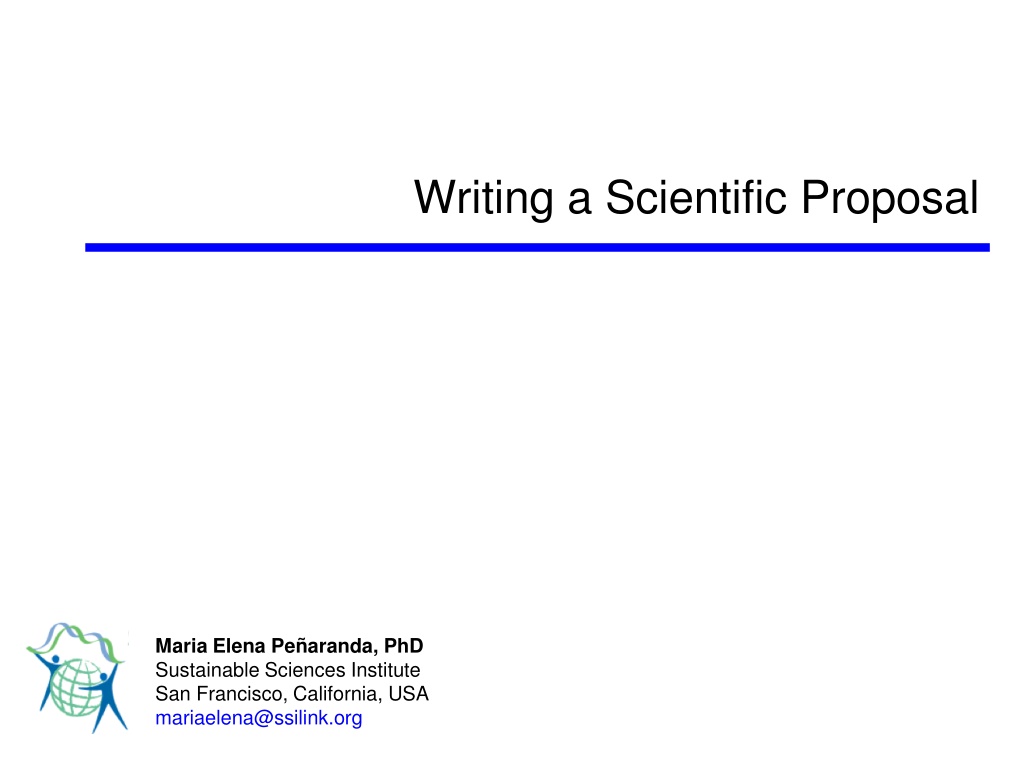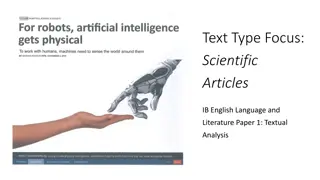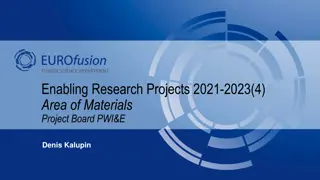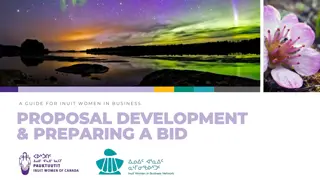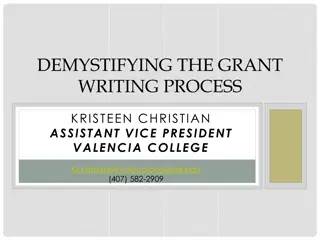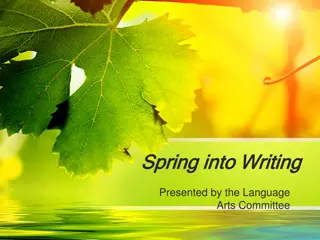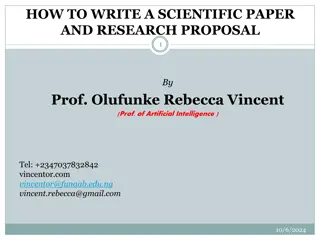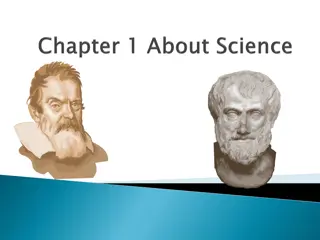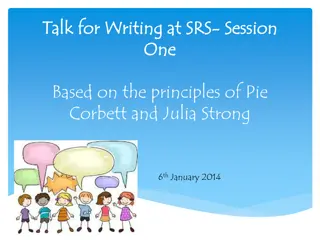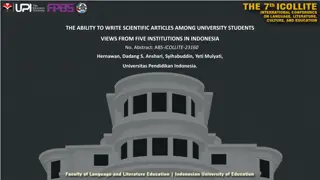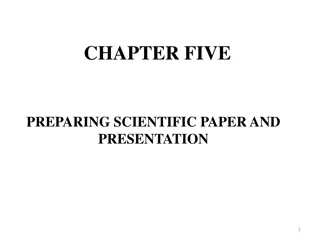Writing a Scientific Proposal
Develop your skills in crafting effective scientific proposals with this workshop led by Dr. Maria Elena Pearanda from the Sustainable Sciences Institute in San Francisco. Dive into key elements of proposal writing and enhance your ability to communicate research ideas persuasively.
Uploaded on Mar 09, 2025 | 0 Views
Download Presentation

Please find below an Image/Link to download the presentation.
The content on the website is provided AS IS for your information and personal use only. It may not be sold, licensed, or shared on other websites without obtaining consent from the author.If you encounter any issues during the download, it is possible that the publisher has removed the file from their server.
You are allowed to download the files provided on this website for personal or commercial use, subject to the condition that they are used lawfully. All files are the property of their respective owners.
The content on the website is provided AS IS for your information and personal use only. It may not be sold, licensed, or shared on other websites without obtaining consent from the author.
E N D
Presentation Transcript
Writing a Scientific Proposal Taller: Escritura de Propuestas de Investigaci n Panam | Mayo 2010 Maria Elena Pe aranda, PhD Sustainable Sciences Institute San Francisco, California, USA mariaelena@ssilink.org 1
A scientific proposal must communicate efficiently an innovative action plan using a concise and specific language The Mayfield Handbook of Technical & Scientific Writing 2 Sustainable Sciences Institute Proposal Writing Workshop
The main objective of the proposal is to be financed $$$$$$$$$$$$$$$$$$$$ Proposals do not get approved due to Inadequate concepts (not clear understanding) Poor presentation (badly written) Poor comprehension of the selection process Lack of persistence 3 Sustainable Sciences Institute Proposal Writing Workshop
Report in a precise and concise language Research is important , innovative and pertinent Research is feasible - With the proposed methodology - With the proposed budget (no more, no less) - With the personal history, good team, preliminary data, logistics Presentation must be coherent and logic 4 Sustainable Sciences Institute Proposal Writing Workshop
SELECTING YOUR THEME How do you narrow down your theme? Laboratory research / previous experience Discussion with peers Detected research needs on the subject: Preliminary data? Recent publications, new ideas, hypothesis, working with a good team Project grants and calls for priorities / financing agencies 5 Sustainable Sciences Institute Proposal Writing Workshop
SELECTING YOUR THEME DON T BE TOO AMBITIOUS! You must be realistic about being able to complete a project within the grant timeframe and having the right contacts to establish collaborations Must interest you, it will be your working topic for a long time Realistic and ready-to-use objectives Have a clear methodology and a well-defined product Be in accord with your academic background Possess objective indicators (Scientific method) 6 Sustainable Sciences Institute Proposal Writing Workshop
SELECTING YOUR THEME DEFINING THE PROJECT Hypothesis test example: "The quality of coffee will be enhanced by using endogenous organisms in the fermentation of Arabica coffee " Methodological example: "Introduce space remote sensing as a monitoring and management tool for coffee plantations" Descriptive to generate an applied hypothesis example: "Investigate the role of seedling containers in the plant vigor of coffee grown in the nursery" 7 Sustainable Sciences Institute Proposal Writing Workshop
STARTING TO WRITE Write a preliminary draft - this does not have to be perfect! Starting is the hardest part but write your ideas down -- get something on paper and don t worry about grammar or spelling Begin to identify your key references 8 Sustainable Sciences Institute Proposal Writing Workshop
STARTING TO WRITE Outline the research activities in a logical sequence Question / Hypothesis Objective(s) Variables Methods Analysis 9 Sustainable Sciences Institute Proposal Writing Workshop
AGENCY GUIDELINES The title and the abstract are the first sections read by the reviewers make them attractive!! The final title and the abstract are the last sections you should write, make them interesting with new possible findings. Begin with a working title but continue to adapt it as you refine your ideas, objectives, impact, etc. 11 Sustainable Sciences Institute Proposal Writing Workshop
Technical description (up to 10 pages, police 12 pt.): - Table of contents - Project novelty and contribution to the subject - Rationale (with justification and references) - Proposed work (detail methodology) - Expected results - Impact of result to the scientific and technical advance of the country - Demonstrate project feasibility at the scientific, technical and logistic levels (objectives vs methodology) - Bibliographic references (latest literature review) - Specific considerations (if any) 12 Sustainable Sciences Institute Proposal Writing Workshop
INTRODUCTION The evaluators are experts on the research area, not necessarily specialists in the exact theme you are proposing research Help them to read: - Provide a logical sequence - Use clear, efficient and concise language Convince them: - Articulate feasibility, relevance, and coherency Respect the indications in the application form: - Pay attention to content guidelines, restrictions, space allocations, budget limits 13 Sustainable Sciences Institute Proposal Writing Workshop
ORIGINAL CONTRIBUTION /INTRODUCTION GENERAL OBJECTIVE FRAME OF REFERENCE PROBLEM - HYPOTHESIS SPECIFIC OBJECTIVES 14 Sustainable Sciences Institute Proposal Writing Workshop
INTRODUCTION ORIGINAL CONTRIBUTION /INTRODUCTION GENERAL OBJECTIVE: BROAD EXPECTED RESULTS - Goal REFERENCE FRAMEWORK Theoretical background of the topic Problem background in the literature PROBLEM Problem identification / previous data Define the project hypothesis There is a novelty and scientific opportunity? 15 Sustainable Sciences Institute Proposal Writing Workshop
INTRODUCTION ORIGINAL CONTRIBUTION /INTRODUCTION General Objective - Broad intention, but realistic of the project (final result), specific objectives must clearly describe a project step Example: "Augmentation among key players through all-inclusive and participatory form of education (project PAKAPE)" Specific objectives (objectives) Quantifiable results and on a specific time for the project Example: "Review project PAKAPE with educators and members of the community " : 16 Sustainable Sciences Institute Proposal Writing Workshop
INTRODUCTION ORIGINAL CONTRIBUTION / INTRODUCTION background problem identification General Specific 17 Sustainable Sciences Institute Proposal Writing Workshop
INTRODUCTION ORIGINAL CONTRIBUTION / INTRODUCTION background problem identification First paragraph -General - Informs the reader why the subject is important: There is a great demand worldwide for good quality coffee production. Some of the best quality coffee is produced in small village farms" 18 Sustainable Sciences Institute Proposal Writing Workshop
INTRODUCTION ORIGINALCONTRIBUTION /INTRODUCTION background problem identification Relationship with other studies: Background and importance Summary of critical findings Critical review of results Approach contradictions Do not forget your own work Include papers of your reviewers (if known) Mention your sources - annexes Arrive in a logical way to the problem 19 Sustainable Sciences Institute Proposal Writing Workshop
INTRODUCTION ORIGINAL CONTRIBUTION / INTRODUCTION Background Known: General-Y is very important (references) (Y=good quality coffee production) G S Q A Unknown: Specific summary Y is not very well characterized in X (references) (X=small villages) Question: Therefore we propose to characterize Y in the case of X that occurs in N number of cases during the U period (references) Methodological approach: To do this we will measure Y using the Q method (references) Proposal Writing Workshop Institute 20 Sustainable Sciences
INTRODUCTION ORIGINAL CONTRIBUTION / INTRODUCTION SPECIFIC OBJECTIVES (OBJECTIVES): - Concrete measures, quali / quantitative to respond the question expressed on the hypothesis - Direct the activities of the proposed work - Guide the evaluation of fulfilled goals - List your specific objectives as a chronological sequence or logical flow Objective 1: Objective 2: Objective 3: 21 Sustainable Sciences Institute Proposal Writing Workshop
JUSTIFICATION PROJECT JUSTIFICATION Problem relevance - Why research is important and why research must be done? - Document the need, indicate the statistical data that supports your case, provide examples - Why your research is different to what has been done up to today? - Which are the innovation and sanitary/ social/ ecological, etc, opportunity ? - Which is the innovation and the international, regional, national, local opportunity? - Offer hope to reviewers, how your project will make a difference? - How will you contribute to solve the problem? 22 Sustainable Sciences Institute Proposal Writing Workshop
JUSTIFICATION Use of figures and maps - ONLY if they contribute to the justification (i.e. incidence curve) or in the proposed work (i.e. map) - Few (one or two) to avoid large paragraphs - Must be self-explicative and simple - Avoid tables or figures previously published, redirect to the concerned bibliographic reference 23 Sustainable Sciences Institute Proposal Writing Workshop
BODY OF WORK Proposed work Parallel activities for each objective Only for the proposed objectives - Could be divided by chapters - Depends of the type of proposal: pilot, training, intervention and follow-up, validation, sensibility, specificity. - Include references and annexes (tools surveys, etc.) - Involve an statistician on the proposal, development and analysis phases 24 Sustainable Sciences Institute Proposal Writing Workshop
BODY OF WORK Proposed work Definitions and background: area /population-sample, epidemiological design, independent variables, dependent variables, intervention (you can include maps or figures) Activities: (specific objectives) 1 (Specific objective 1) 1.a. Activity/experiment 1 1.b. Activity/experiment 2 1.c. Activity/experiment 3 2 (Specific objective 2) 2.a. Specific Objective 2.b. Specific Objective 3 (Specific Objective 3) etc. 25 Sustainable Sciences Institute Proposal Writing Workshop
BODY OF WORK Proposed work ACTIVITIES For each activity, why is your method the best? Only include the activities related the proposed objectives Give small details: -methodology, who and when? -controls -instruments to use -information to collect -analysis of data 26 Sustainable Sciences Institute Proposal Writing Workshop
BODY OF WORK Proposed work Parallel activities for each objective Could be divided on chapters Depends on the type of proposal: pilot, training, intervention-follow-up, validation, sensibility, specificity. Include references and annexes (tools surveys, etc.) Involve an statistician on the proposal, development and analysis phases Methodology of collection and information analysis 27 Sustainable Sciences Institute Proposal Writing Workshop
BODY OF WORK Proposed work METHODS General (Subtitle or the first sentence in the paragraph "Space Remote Sensing" Specific details (rest of the paragraph) The method consists of xxx developed by Drs...(ref) 28 Sustainable Sciences Institute Proposal Writing Workshop
BODY OF WORK Proposed work METHODS: References -You can reference a previous paper related to the methods you will use, but be specific. NOT CLEAR The method already described will be used (9)" BETTER Space Remote sensing (described by, ref) will be used to monitor...." -Describe briefly the protocol 29 Sustainable Sciences Institute Proposal Writing Workshop
RESULTS EXPECTED RESULTS -List precisely the expected results at the end of the project for each activity and their global impact (implementation of management strategies for pests and diseases will increase the sustainability of coffee production by.....) -Organize then in the same sequence of the aims and activities 30 Sustainable Sciences Institute Proposal Writing Workshop
RESULTS Impact Baseline (pre) and expected (post) COUNTRY / REGION / INSTITUTION - Knowledge and abilities acquired - Technology developed / incorporated - Human resources formation - Diffusion and publications - Transference (explained in methods) 31 Sustainable Sciences Institute Proposal Writing Workshop
OTHER SUPPORT Scientific, technical and logistical feasibility of the project Academic and experiment background in the subject from the candidate, the team, and the institution Location, infrastructure and adequate equipment Logistics of access to primary and secondary data Time and budget consistent with objectives, infrastructure and logistics Institutional administrative capacity, other funding sources confluent 32 Sustainable Sciences Institute Proposal Writing Workshop
LIMITATIONS Scientific, technical and logistical feasibility of the project LIMITATIONS - WEAKNESSES -Scientific, technical, logistics -Of probability, from particular to general Sequential activities: if one of the first fails It uses a single device throughout the country: if it breaks If extraordinary rains as in previous year If social instability in the region, alternative region If periodic costs and inflation rate soars If a giant meteorite hits the world noting matters MITIGATE POSSIBLE DIFFICULTIES: Only feasible and more likely difficulties 33 Sustainable Sciences Institute Proposal Writing Workshop
REFERENCES REFERENCES According format of scientific publications Only relevant, logical number: 10 to 30 Check with the text that is listed or missing Reviewers : international - regional - local Own references and from possible reviewers SPECIAL CONSIDERATIONS Ethical, environmental, intellectual property, regional, etc. 34 Sustainable Sciences Institute Proposal Writing Workshop
TIME LINE CRONOGRAM -Timeline, in the same order and numbering of the activities by stage and by month -If more than one institution is involved, clarify what each one is doing Include analysis, reporting and monitoring (at least as often as requested by agency) Show that you are familiar with the methods. Sustainable Sciences Institute 35 Proposal Writing Workshop
ATTACHMENTS Additional information Cover letter or letter of intent Annexes: - Letters of recommendation - Letters from collaborators - Resume of researchers (proposed function) - Instruments (ex. surveys) or protocols - Ethical committee - Partnerships - Codification manuals 36 Sustainable Sciences Institute Proposal Writing Workshop
EVALUATION CRITERIA QUALITY Creativity Originality Potential for discovery RELEVANCE PERTINENCE COHERENT Logic / Racional Background of the group Literature support Clarity COST-EFECTIVITY 37 Sustainable Sciences Institute Proposal Writing Workshop
EVALUATION CRITERIA How proposals are evaluated 1. Significance: does the study address an important problem? How will scientific knowledge be advanced? 2. Approach: are design and methodology well- developed and appropriate? Are problem areas address? 3. Innovation: are there novel concepts or approaches? 4. Investigator: is the investigator appropriately trained? 5. Environmental: do the scientific environment contribute to the probability of success? Are there unique features of the scientific environment? Overall Evaluation & Score reflects impact on the field 38 Sustainable Sciences Institute Proposal Writing Workshop
EVALUATION CRITERIA How not to be accepted Illegible proposal Not persuasive Untidy presentation Unclear Vague Lack of planning Budget problems Omission of supplemental materials Weak recommendations 1. 2. 3. 4. 5. 6. 7. 8. 9. 10. Lack of compliance with deadline 39 Sustainable Sciences Institute Proposal Writing Workshop
Get feedback Present your work orally, formally or informally - It reveals gaps - Receive suggestions - Re-write Re-read the guidelines Review the checklist one last time SEND IT IN TIME WITH ALL THE ATTACHMENTS! 40 Sustainable Sciences Institute Proposal Writing Workshop
ACCEPTED Received financing! The work is just beginning Be aware of reporting requirements Most agencies do not send additional funds until your mid term report is received Many agencies ask for interim and final reports 41 Sustainable Sciences Institute Proposal Writing Workshop
NOT ACCEPTED Did not received funding Keep trying! - No Do not give up you are in good company - It is not uncommon to be rejected (is a learning process) - - Modify the proposal as the recommendations received and send it again - Sometimes you must send the proposal on several occasions or to different agencies 42 Sustainable Sciences Institute Proposal Writing Workshop
